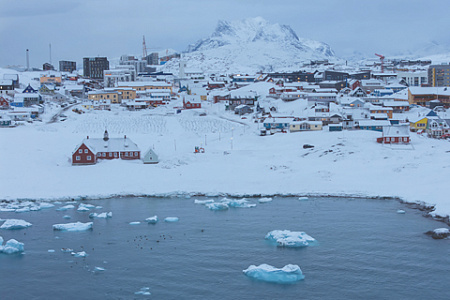
The negative reaction of the Greenlandic authorities to the three-day visit of the American delegation headed by the Second Lady of the United States, Usha Vance, the wife of Vice President Jay Dee Vance, which begins on Thursday, did not come as a surprise. On March 14, the leaders of the five parties that won seats in the island’s parliament following the recent elections issued a joint statement. They spoke about the inadmissibility of the annexation of Greenland, which US President Donald Trump considered quite possible at a meeting with NATO Secretary General Mark Rutte a day earlier, answering a question from journalists.
Trump argued his position with the “national interests of the United States,” including in the field of security. He threatened to impose high trade duties on Denmark if Copenhagen did not give up the island.
The White House said in a statement that the US delegation will visit the island’s attractions, watch traditional dog sledding races, and also visit the Pituffik military space base in northern Greenland. Nevertheless, most Greenlandic politicians criticized the upcoming visit, calling it a provocation. This assessment was given, in particular, by the Prime Minister of the autonomy Government, Myute Egede.
In turn, Danish Foreign Minister Lars Loekke Rasmussen said that the visit of the American delegation to Greenland is part of the US efforts to bring the island closer to Washington. He fully shares the opinion of the Greenlandic authorities, who consider the arrival of Americans at this time and at this level to be “problematic.”
The Americans’ stay on the island is particularly painful due to the fact that a new government is being formed in Greenland. At the same time, on Monday, when the visit became known, the Nalerak party withdrew from the inter-party negotiations. She is more active than others in defending the island’s independence as soon as possible and has previously advocated pro-American positions. But during the election campaign and now he joins the general anti-American sentiments and statements.
In particular, they relate to the discrepancy between Greenlandic and American priorities. For example, Chris Wright, the US Secretary of Energy, spoke out in support of all available energy sources during the Senate confirmation hearings. But he later stated that there is no viable alternative to oil, gas and coal. And in the strategy for the development of Greenland’s natural resources for 2025-2029, which was presented in January by the previous government, hydrocarbons and their reserves on the island are never mentioned, as the focus is on hydropower. So Greenland’s priorities are more aligned with the European Union’s agenda.
In the near future, most likely, we can expect visits by European politicians to Greenland in order to create some kind of counterweight to American insistence. The Greenlandic side has already addressed the EU and the European Parliament (EP) with this request, when a group of Danish EP members visited the island.
Per Clausen, a member of the EP from the United List party, which is close to the far-left Inuit Atakatigiit party, said shortly after the news of the planned visit of the second lady of the United States: “When Greenland directly asks for support to fight back against the United States, we must act. Therefore, I will urge Brussels, in cooperation with the Danish government, to start negotiations with Greenland on how the EU can specifically work closely with the island to ensure its social and economic development.”
In addition, Clausen proposed that a delegation from the left faction in the EP could visit Greenland after the municipal elections scheduled for April 1 and the formation of a government to discuss specific areas of cooperation.
This would be very appropriate, since excessive coverage of American statements regarding Greenland distracts from discussing more important challenges and prospects for the autonomy’s internal economic development. For example, environmental safety, fishing and maritime transport in the North Atlantic may be affected by activity at the military space station in the Shetland Islands, where the first commercial launches are planned this year.
In March, the Greenlandic government announced that the budget for 2025 provides subsidies for the development of agriculture and the food industry as part of improving the island’s food security. It remains unclear how much the United States can contribute to solving these island problems and, as Trump himself stated, “enrich the Greenlanders.”
When the United States starts talking to Greenland about specific problems of its development and ways to solve them, then the attitude of Nuuk and Washington will acquire a different, more constructive tone. However, this is more likely to bring some discord into relations between Denmark and Greenland, rather than bring them closer, which is partly happening now.
By the way, the fishing industry in American Alaska is experiencing an acute crisis, which is caused by both falling demand for seafood and rising operating costs, as well as warming Arctic waters, which negatively affects fish populations in the Bering Sea and the North Pacific Ocean. This crisis has particularly affected small coastal towns and settlements that depend on the use of marine biological resources. Therefore, the US federal authorities, most likely, will have to think not so much about buying a new territory as about investing in the transport infrastructure of their Arctic state and modernizing the fishing fleet, which lags far behind the Russian and Chinese.
Meanwhile, it became known that police forces have been sent from Copenhagen to Greenland to ensure security during the visit of the Americans. At the same time, the National Police Department did not specify the tasks of the guards on the island.
